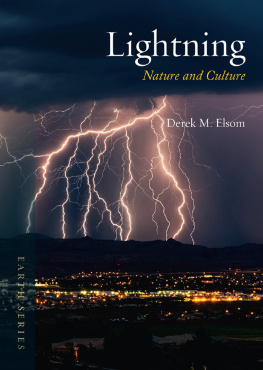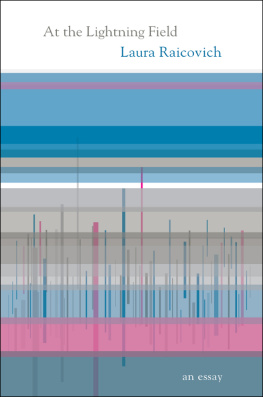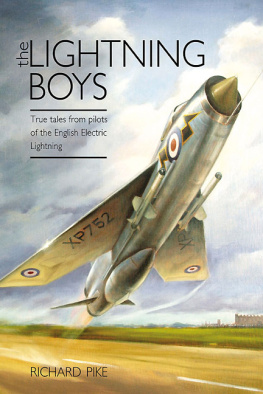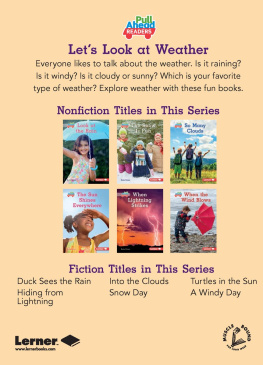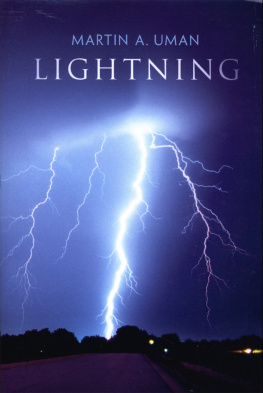LIGHTNING

The Earth series traces the historical significance and cultural history of natural phenomena. Written by experts who are passionate about their subject, titles in the series bring together science, art, literature, mythology, religion and popular culture, exploring and explaining the planet we inhabit in new and exciting ways.
Series editor: Daniel Allen
In the same series
Air Peter Adey
Cave Ralph Crane and Lisa Fletcher
Desert Roslynn D. Haynes
Earthquake Andrew Robinson
Fire Stephen J. Pyne
Flood John Withington
Islands Stephen A. Royle
Lightning Derek M. Elsom
Meteorite Maria Golia
Moon Edgar Williams
Tsunami Richard Hamblyn
Volcano James Hamilton
Water Veronica Strang
Waterfall Brian J. Hudson
Lightning
Derek M. Elsom
REAKTION BOOKS
For Elizabeth, my wife
Published by
Reaktion Books Ltd
33 Great Sutton Street
London EC1V 0DX, UK
www.reaktionbooks.co.uk
First published 2015
Copyright Derek M. Elsom 2015
All rights reserved
No part of this publication may be reproduced, stored in a retrieval system, or transmitted, in any form or by any means, electronic, mechanical, photocopying, recording or otherwise, without the prior permission of the publishers
Page references in the Photo Acknowledgements and
Index match the printed edition of this book.
Printed and bound in China
A catalogue record for this book is available from the British Library
eISBN: 9781780235462
CONTENTS

Stunning lightning display from a supercell thunderstorm, Nevada, U.S.
Preface
Thunder is good, thunder is impressive; but it is lightning that does the work.
Thunderstorms produce thunder and lightning. Although thunder can rattle windows, trigger vehicle alarms and terrify some people, it is lightning that causes serious damage and disruption to our lives, even threatening us directly with injury and death. Lightning is awesome and beautiful to watch, but it is dangerous too. With around four million lightning flashes happening every day throughout the world, it is a weather threat that demands our attention and respect.
The content of this book reflects my lifetimes interest in enjoying the spectacle of lightning natures own stunning firework display. Each lightning display is unique in form, composition and colour. My fascination with lightning has encouraged a desire to understand how lightning has featured in the lives of people in the past and present in terms of mythology, folklore, science and the arts.
The changing attitudes to lightning are also explored. The belief that lightning was so powerful that only gods and goddesses could generate and control it dominated early civilizations. They created thunder, lightning or simply storm deities in many forms, each with a different means of generating thunder and lightning. By medieval times these storm deities were supplanted by modern religious beliefs, although folklore concerning the old gods and goddesses was retained by some individuals and communities. Consequently, objects associated with the old deities stone thunderbolts, certain plants and other items thought to have magical properties were used to protect families and their homes from being struck by lightning.
In medieval times the fear that lightning could be directed by evil individuals such as witches resulted in many of those accused being tortured and put to death. Although the persecution of lightning-controlling witches ended in the eighteenth century in Europe and North America, it remains a belief within some traditional communities in countries across the world. In 1990 South Africa even established ten remote villages as safe havens for hundreds of people accused of practising witchcraft.
Since the mid-eighteenth century, science has helped explain the nature and formation of lightning. Proof that lightning is an electric current (or electric fluid as it was initially called in popular terms) has enabled us to develop ways to minimize the damage and disruption it causes. The process by which lightning is formed is explained in this book along with the actions being taken to tackle the threat lightning poses to our forests, buildings, power supplies, aircraft and spacecraft.
The risks of people being struck and injured by lightning are explored and the ways to minimize the chances of being struck places to avoid and areas to seek shelter, both outdoors and indoors are discussed. This will help readers avoid being in the wrong place at the wrong time when thunderstorms develop.
Finally, the many ways in which lightning pervades art, literature and popular culture are outlined, with examples given of how lightning features in everyday expressions, books, films, comic strips, paintings, heraldry and sculptures.
This book is wide-ranging in its coverage of lightning-related subjects and, for those readers wanting to find out even more about a specific topic, I hope it marks the beginning of many more years of adding to their knowledge and appreciation of lightning.
1 Weapon of the Gods and Goddesses
To early civilizations, lightning was considered so powerful and terrifying that only gods or goddesses could generate and discharge it. Their creation stories, beliefs and mythologies embodied lightning, thunder and other natural forces. Many cultures thought lightning was the visible sign of a fiery, stony weapon (a thunderbolt) thrown by the storm deity in the sky, and that thunder was the noise it created as it hurtled toward the ground. Other cultures thought lightning was discharged through the deitys use of a whip or slingshot accompanied by the distinctive crack of thunder, or thunder was the noise of the beating of drums, the turning of the wheels of a storm deitys chariot or the bellowing voice of the god or goddess. For others, lightning and thunder were the flashing eyes and beating wings of a giant Thunderbird.
Although some early cultures and civilizations extended their influence at a continental scale for many centuries and imposed their deities on those they conquered, there were many civilizations throughout the world that controlled a relatively limited area for only a century or two. People in these independent domains or city states often had their own language and developed their own mythology. Their creation myths and folklore were influenced by factors such as their physical environment and climate, the dangers they faced and the main activities that fed and sustained their communities. These early peoples experienced difficult and slow lines of communication and trade with neighbouring cultures, let alone more distant ones. With such a large number and diversity of relatively small-scale cultures and civilizations, the result was the emergence of hundreds of gods and goddesses of lightning and thunder throughout the world. Only a relatively small proportion of them are well known today, while the rest have been poorly documented or forgotten entirely.

Early civilizations believed only a god or goddess could create lightning. Lightning near Deming, New Mexico.

